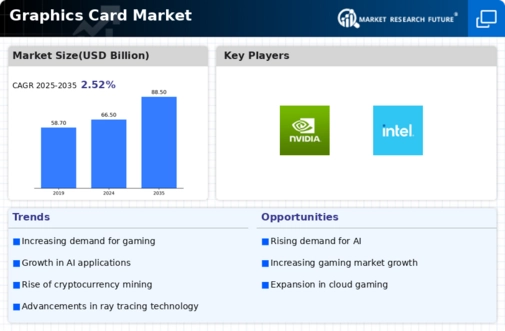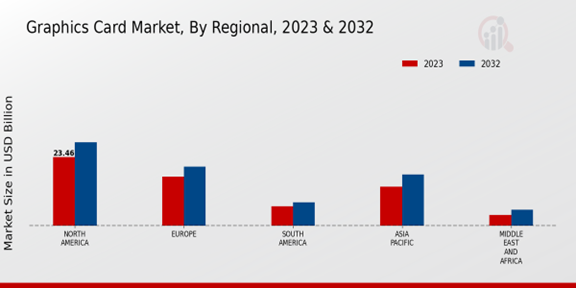Increasing Demand for Gaming
The Global Graphics Card Market Industry experiences a notable surge in demand driven by the gaming sector. As gaming technology advances, consumers seek high-performance graphics cards to enhance their gaming experience. In 2024, the market is projected to reach 66.5 USD Billion, reflecting the industry's growth potential. Gamers increasingly prefer graphics cards that support high resolutions and frame rates, leading to a competitive landscape among manufacturers. This trend is likely to continue as the gaming community expands, with projections indicating a steady growth trajectory through 2035, when the market could reach 88.5 USD Billion.
Market Trends and Projections
The Global Graphics Card Market Industry is poised for growth, with projections indicating a market size of 66.5 USD Billion in 2024 and an expected increase to 88.5 USD Billion by 2035. The compound annual growth rate of 2.64% from 2025 to 2035 reflects the industry's resilience and adaptability to changing consumer needs. Key trends include the growing demand for gaming, advancements in graphics technology, and the rise of AI applications. These factors collectively contribute to a dynamic market landscape, where innovation and consumer preferences shape the future of graphics card development.
Growth in Cryptocurrency Mining
Cryptocurrency mining has emerged as a critical driver for the Global Graphics Card Market Industry. Miners require high-performance GPUs to solve complex mathematical problems, which in turn validates transactions on blockchain networks. As cryptocurrencies gain traction, the demand for specialized graphics cards has surged, leading to increased sales and market expansion. While the market may experience fluctuations due to regulatory changes and market volatility, the underlying demand for efficient mining hardware remains strong. This dynamic could contribute to the overall growth of the market, particularly as new cryptocurrencies are introduced and mining technologies advance.
Rise of AI and Machine Learning
The integration of artificial intelligence and machine learning technologies significantly influences the Global Graphics Card Market Industry. Graphics cards are essential for processing complex algorithms and large datasets, making them indispensable in AI applications. As industries increasingly adopt AI solutions, the demand for powerful graphics processing units (GPUs) is expected to rise. This trend suggests a potential shift in focus from traditional gaming applications to more diverse sectors, including healthcare and finance. The anticipated compound annual growth rate of 2.64% from 2025 to 2035 indicates that the market will likely expand as AI technologies evolve.
Advancements in Graphics Technology
Technological advancements in graphics processing significantly impact the Global Graphics Card Market Industry. Innovations such as ray tracing, real-time rendering, and enhanced VR capabilities drive consumer interest and demand for cutting-edge graphics cards. Manufacturers are continually developing new architectures and technologies to improve performance and efficiency. As these advancements become mainstream, consumers are likely to upgrade their systems to take advantage of the latest features. This trend not only boosts sales but also encourages competition among manufacturers to deliver superior products, thereby fostering a robust market environment.
Increased Adoption of 4K and 8K Displays
The rising adoption of 4K and 8K displays is a pivotal factor influencing the Global Graphics Card Market Industry. As consumers upgrade their display technologies, the need for powerful graphics cards capable of supporting higher resolutions becomes paramount. This trend is particularly evident in gaming, content creation, and professional visualization sectors. Graphics cards must deliver exceptional performance to meet the demands of these high-resolution displays, driving sales and market growth. The combination of enhanced visual experiences and the increasing availability of 4K and 8K content suggests a sustained demand for advanced graphics solutions in the coming years.




